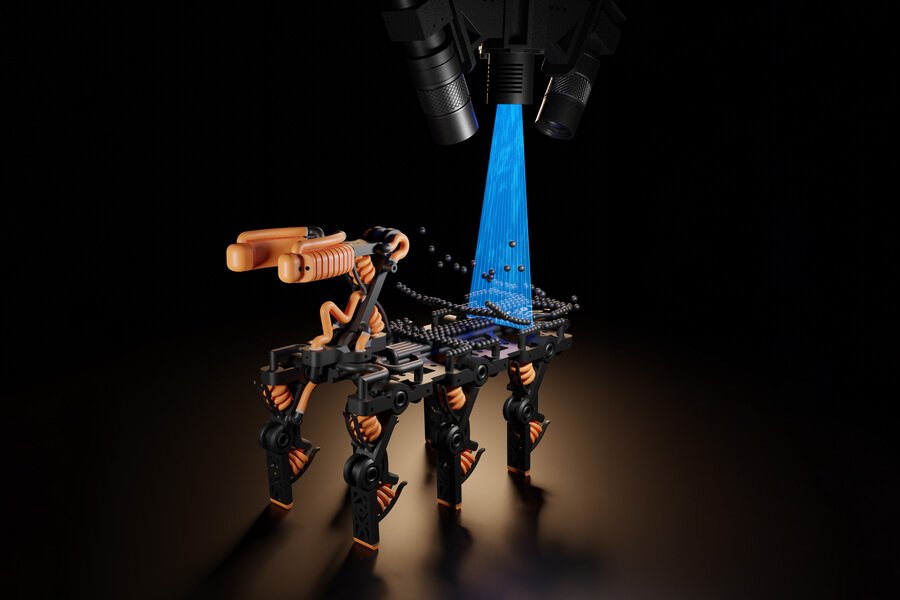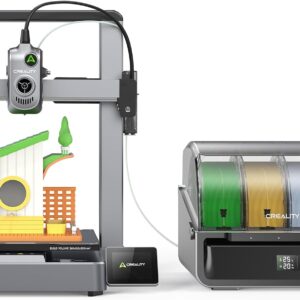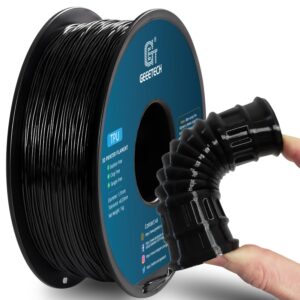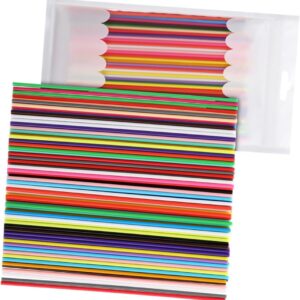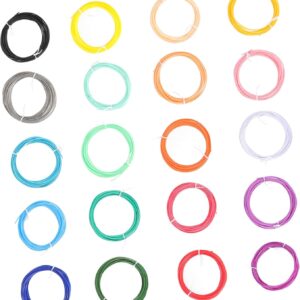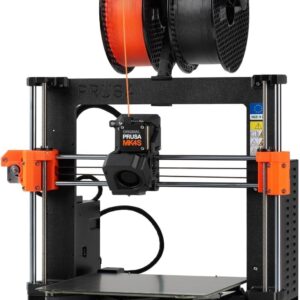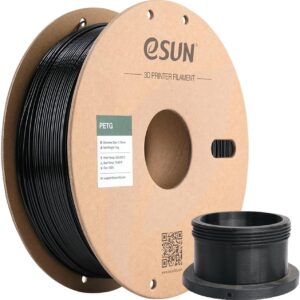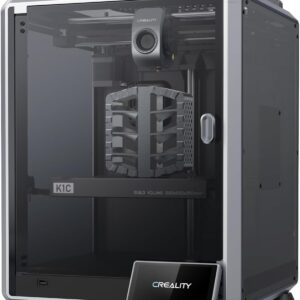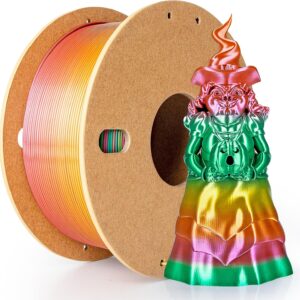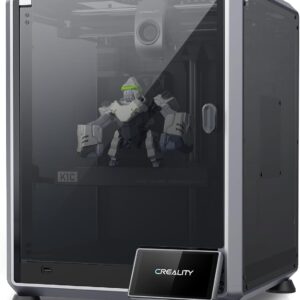Using 3D inkjet printing systems, engineers can create hybrid structures with soft and rigid components, such as robotic grippers that are strong enough to grip heavy objects but soft enough to safely interact with people.
This rendering shows a robot that is built layer by layer using the new process. The black balls represent the material the printer uses. The material is then cured by UV light, shown in blue. At the top of the image are the cameras that scan the process and adjust accordingly. Image: Moritz Hocher.
These multi-material 3D printing systems use thousands of nozzles to apply tiny droplets of resin, which are smoothed with a scraper or roller and cured with UV light. However, the smoothing process could crush or smear slow-curing resins, limiting the types of materials that can be used.
Researchers from MIT, the MIT spinout Inkbit and ETH Zurich have developed a new 3D inkjet printing system that works with a much wider range of materials. Your printer uses computer vision to automatically scan the 3D printing surface and adjust the amount of resin each nozzle applies in real time to ensure no areas contain too much or too little material.
 The researchers used their printing system to develop complex robotic devices that combine soft and rigid materials. Since the printer has 16,000 nozzles, the system can control fine details of the device being manufactured. This representation shows objects that are half created by the printer. Photo credit: Courtesy of the researchers.
The researchers used their printing system to develop complex robotic devices that combine soft and rigid materials. Since the printer has 16,000 nozzles, the system can control fine details of the device being manufactured. This representation shows objects that are half created by the printer. Photo credit: Courtesy of the researchers.
Because no mechanical parts are required to smooth the resin, this non-contact system works with materials that cure more slowly than the acrylates traditionally used in 3D printing. Some slower-curing material chemistries may offer better performance over acrylates, e.g. B. greater elasticity, durability or longevity.
Additionally, the automated system makes adjustments without stopping or slowing the printing process, making this production-ready printer approximately 660 times faster than a comparable 3D inkjet printing system.
 The researchers created a functional, tendon-driven robotic hand that features 19 independently actuable tendons, soft fingers with sensor pads, and rigid, load-bearing bones. Photo credit: Courtesy of the researchers.
The researchers created a functional, tendon-driven robotic hand that features 19 independently actuable tendons, soft fingers with sensor pads, and rigid, load-bearing bones. Photo credit: Courtesy of the researchers.
Researchers used this printer to develop complex robotic devices that combine soft and rigid materials. For example, they made a fully 3D printed robotic gripper shaped like a human hand and controlled by a set of reinforced but flexible tendons.
“Our most important finding here was the development of an image processing system and a fully active feedback loop. “It’s almost like equipping a printer with eyes and a brain, where the eyes watch what is printed and then the brain instructs the machine what to print next,” says co-corresponding author Wojciech Matusik, Professor of Electrical Engineering and Computer Science at MIT who leads the Computational Design and Fabrication Group within the MIT Computer Science and Artificial Intelligence Laboratory (CSAIL).
 A rendering shows the robot hand’s printing process, with white balls representing the material used by the printer. Image: Moritz Hocher.
A rendering shows the robot hand’s printing process, with white balls representing the material used by the printer. Image: Moritz Hocher.
He is supported on the article by lead author Thomas Buchner, a doctoral student at ETH Zurich, co-correspondent Robert Katzschmann PhD ’18, assistant professor of robotics who leads the Soft Robotics Laboratory at ETH Zurich; as well as others at ETH Zurich and Inkbit. The research recently appeared in Nature.
Contact-free
This paper builds on a low-cost, multi-material 3D printer called MultiFab that the researchers introduced in 2015. By using thousands of nozzles to deposit tiny, UV-cured resin droplets, MultiFab enabled high-resolution 3D printing of up to 10 materials at once.
With this new project, researchers sought a non-contact process that would expand the range of materials they could use to create more complex devices.
 A photo shows various 3D printed objects in white displayed on a tray. The objects include a robotic hand, cubes made of lattice structures, a biological heart and a walking robot. Photo credit: Courtesy of the researchers.
A photo shows various 3D printed objects in white displayed on a tray. The objects include a robotic hand, cubes made of lattice structures, a biological heart and a walking robot. Photo credit: Courtesy of the researchers.
They developed a technique called vision-controlled jetting, in which four high-frame-rate cameras and two lasers scan the print surface quickly and continuously. The cameras capture images while thousands of nozzles release tiny droplets of resin.
The computer vision system converts the image into a high-resolution depth map, a calculation that takes less than a second. It compares the depth map to the computer-aided design (CAD) model of the part being manufactured and adjusts the amount of resin applied to hold the object at the target with the final structure.
The automated system can make adjustments to each individual nozzle. Since the printer has 16,000 nozzles, the system can control fine details of the device being manufactured.
“Geometrically speaking, it can print almost anything you want in multiple materials. There are almost no restrictions when it comes to print output, and the result is really functional and long-lasting,” says Katzschmann.
The level of control the system offers makes it possible to print very precisely with wax, which is used as a substrate to create cavities or intricate channel networks inside an object. The wax is printed under the structure when the device is manufactured. Once completed, the object is heated so that the wax melts and flows away, leaving open channels throughout the object.
Because the system can automatically and quickly adjust the amount of material applied by each nozzle in real time, the system does not need to drag a mechanical part across the print surface to keep it flat. This allows the printer to use materials that cure more slowly and would be smeared by a scraper.
Superior materials
The researchers used the system to print with thiol-based materials, which cure more slowly than the traditional acrylic materials used in 3D printing. However, thiol-based materials are more elastic and do not break as easily as acrylates. They also tend to be more stable over a wider temperature range and do not decompose as quickly when exposed to sunlight.
“These are very important properties if you want to make robots or systems that have to interact with a real environment,” says Katzschmann.
The researchers used thiol-based materials and wax to create several complex devices that would otherwise be difficult to produce using existing 3D printing systems. First, they created a functional, tendon-driven robotic hand that has 19 independently actuable tendons, soft fingers with sensor pads, and rigid, load-bearing bones.
“We have also developed a six-legged walking robot that can recognize and grasp objects. This was possible because the system is able to create airtight interfaces between soft and rigid materials as well as complex channels within the structure,” says Buchner.
The team also demonstrated the technology using a heart-like pump with integrated ventricles and artificial heart valves, as well as metamaterials that can be programmed to have nonlinear material properties.
“That’s just the beginning. There are an amazing number of new types of materials you can add to this technology. This allows us to introduce completely new families of materials that previously could not be used in 3D printing,” says Prof. Matusik.
The researchers are now considering using the system to print with hydrogels used in tissue engineering applications, as well as silicone materials, epoxy resins and special types of durable polymers.
They also want to explore new applications, such as printing customizable medical devices, semiconductor polishing pads and even more complex robots.
